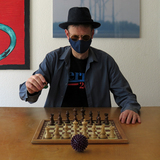SHAPE & GEOMETRY
of Crop Circle Formations found from 1990 to 1995
by Wolfgang Schindler
This is the price your customers see. Edit list price
About the Book
Circular imprints of flattened crops have been found in European fields and meadows since the early sixteenth century. In those days they were usually considered the results of sorcery, hence the names they were given, such as "fairy rings" or "devil's circles". And though the few researchers who approached this mystery with scientific measures came to the conclusion that its causes lay in the meteorological rather than in the metaphysical, it took more than fourhundred years for crop circles to receive wider public attention.
It was not until the 1980s that crop circles gained worldwide television and press coverage. As this happened, the number of circles appearing every year increased rapidly, especially in the English counties of Hampshire and Wiltshire, the home of famous neolithic monuments like Stonehenge and Avebury. And it was in these two counties that the public eye watched the crop circle phenomenon change dramatically: Crop circles were not just circles anymore, instead they became sign-like assemblies of circles connected with lines and encompassed and accompanied by rings, bars, and other geometrical shapes.
In subsequent years the crop circle formations, as they were now called, evolved into large mandalas for the landscape, and they still appear like this every summer to this day. This book focuses on the period between 1990 and 1995, when it was not at all clear whether the crop circle formations were merely traces of an unknown meteorological phenomenon, or signs left by artists, or even a mysterious non-human agency trying to make contact with humankind. Whatever it was, these years saw the rise of a new kind of art: Pictures in fields to be seen from the air, and made by a collective of unknown artists.
It was not until the 1980s that crop circles gained worldwide television and press coverage. As this happened, the number of circles appearing every year increased rapidly, especially in the English counties of Hampshire and Wiltshire, the home of famous neolithic monuments like Stonehenge and Avebury. And it was in these two counties that the public eye watched the crop circle phenomenon change dramatically: Crop circles were not just circles anymore, instead they became sign-like assemblies of circles connected with lines and encompassed and accompanied by rings, bars, and other geometrical shapes.
In subsequent years the crop circle formations, as they were now called, evolved into large mandalas for the landscape, and they still appear like this every summer to this day. This book focuses on the period between 1990 and 1995, when it was not at all clear whether the crop circle formations were merely traces of an unknown meteorological phenomenon, or signs left by artists, or even a mysterious non-human agency trying to make contact with humankind. Whatever it was, these years saw the rise of a new kind of art: Pictures in fields to be seen from the air, and made by a collective of unknown artists.
Author website
See More
About the Creator
Wolfgang Schindler
Hamburg, Germany
Wolfgang Schindler was in born in Hamburg, Germany, in 1962. He learned to read and write in the sixties. All of the seventies he spent in school. In the eighties he worked as a postman and as a salesman, then went to university to study architecture, arabic, and arts. During the nineties he called himself an artist and he helped organizing exhibitions for other artists. In the first decade of the twenty-first century he had to close the showroom and worked again as a postman. All his life he carried a camera and took thousands of photos. He still lives in Hamburg.


